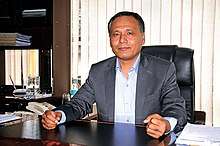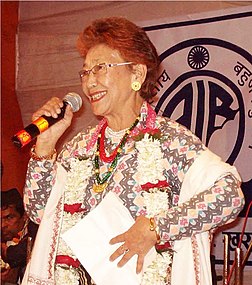Tamang people
The Tamang (ཏ་མང; Devanagari: तामाङ्ग; tāmāng) are an ethnic group orginating in Nepal. Tamang people constitute 5.6% of the Nepalese population at over 1.3 million in 2001, increasing to 1,539,830 as of the 2011 census.[1] Tamang people are also found in significant numbers in Indian state of Sikkim and districts of Darjeeling and Kalimpong in India, as permanent settlers.[2] Tamang language is the fifth most spoken language in Nepal.[3]
| Regions with significant populations | |
|---|---|
| Nepal, India (Sikkim, Darjeeling, Kalimpong) | |
| Languages | |
| Tamang, Nepali | |
| Related ethnic groups | |
| Sherpa, Gurung, Thakali, Hyolmo |
Etymology
Tamang may be derived from the word Tamang, where Ta means "horse" and Mag means war in Tibetan. However there are no written documentations of Horse Rider naming nor present Tamang people have horse riding culture.[4][4]
Political participation
Tamangs are represented by Tamsaling Rastriya Mukti Morcha and Tamsaling Nepal Rastriya Dal. The umbrella group Mongol National Organisation (MNO) supports self-determination and opposes discrimination, not just for Tamangs but for all groups in Nepal. The MNO is against conversion of non-Hindus to Hinduism. It currently holds no official parliamentary vote. The Federal Limbuwan State Council (FLSC) also works towards similar goals for self-determination for the Kirati peoples, who co-mingle with Tamangs, citing a reneged treaty with Kathmandu for autonomy.[5] The associated Sanghiya Limbuwan Party has participated in calling banda during the 2015 Nepal blockade,[6] but this did not attract the attention of the international press.[7] In the 1980s, a violent Gorkhaland movement within India led by the prominent Tamang Subhas Ghising was viewed as a security threat due to the proximity of the Siliguri Corridor.[2] Madan Tamang, a Tamang-Indian politician and proponent for Gorkhaland statehood, was assassinated in 2010, with the West Bengal government placing blame on another Gorkhaland political party, in effect weakening the movement. Gorkhaland Territorial Administration was created in place of statehood in India. In Nepal, ethnic discrimination issues regarding numerous groups (who have taken part in each other's politics) have been left unresolved. In 2017 Binay Tamang was appointed as the Chairperson of GTA.[8]
Culture
Tamang tradition and culture includes a distinct language, culture, dress and social structure. They have over 100 sub-clans. About 90% of the Tamang are Buddhist. Their language comes from the Tibeto-Burman language family. They follow the Chinese lunar calendar of the 12-year cycle. Colorful printed Buddhist mantra cloths are put up in various places in villages and towns.[1]
Their typical song and dance style is known as Tamang Selo, and includes songs of humor, satire, joy and sorrow. It has a brisk movement and rhythmic beat specific to the Tamangs.[2] A distinctive musical instrument is the damphu, a small round drum covered with goatskin.
Festivals
.jpg)
Sonam Lhochhar is the main festival of the Tamangs and is celebrated in the month of Magh (February–March).[9] It is celebrated to welcome the Tamang new year.
The second most important festival is (Buddha Jayanti), a religious festival.[4]
Dashain and Tihar are also enthusiastically celebrated by Tamangs.[1]
Livelihood
Most Tamangs are farmers. Due to the lack of irrigation at higher altitudes, their crops are often limited to corn, millet, wheat, barley, and potatoes. Also, Tamang farmers are dependent on rainfall and do not employ modern machinery. They often supplement their farming income with manual labour. Due to the discrimination experienced by the Tamang people in the past, they have remained on the whole poorly educated, and the majority have been limited to working as farmers, mountain trekking, portering, and driving in Kathmandu as well as serve British gurkha and indian Gorkha. They also work in the manufacture of Tibetan rugs, Thankas (Tibetan painting), driving and labour.[1]
Trekking and tourism
Tamang villages are often visited on Nepal's numerous trekking routes, one being labelled Tamang Heritage Trail.[10]
Notable Tamangs

- Hira Devi Waiba, singer[11]
- Navneet Aditya Waiba
- First Tamang IGP Pahal Singh Lama, Yonjon (Popularly known as PS Lama).
- First Tamang Pilot Amar Jung Tamang Pakhrin (Popularly known as AJ Tamang)
- Phiroj Shyangden
- Raju Lama
- Parijat (writer)
- Prashant Tamang[12]
- Zenisha Moktan[13]
- Nima Rumba[14]
- Aruna Lama[15]
- Karma Yonzon
- Gopal Yonjan[16]
- Kul Man Ghising
- DB Lama
- Vijaya Lama
- Robin Tamang
- VTEN (Samir Ghising)
References
- "Archived copy" (PDF). Archived (PDF) from the original on 2016-03-04. Retrieved 2015-12-22.CS1 maint: archived copy as title (link)
- "Archived copy". Archived from the original on 2016-04-27. Retrieved 2015-12-23.CS1 maint: archived copy as title (link) Emergent North-East : A Way Forward By H. C. Sadangi
- "Report on Socio-Economic Status of Tamang–Kavre". Nefin.org.np. Archived from the original on 2013-03-12. Retrieved 2015-12-23.
- "Who actually are the Tamang People? An Insight into Indigenous Tribe of Nepal". Chronicles of ADVENTURE TRAVEL. 2015-01-05. Archived from the original on 2018-03-01. Retrieved 2018-02-28.
- Chemjong, Iman Singh (2003). History and Culture of Kirat People (4th ed.). Kathmandu: Kirat Yakthung Chumlung. ISBN 99933-809-1-1.
- "Sanghiya Limbuwan Party calls indefinite Eastern Region bandh". The Himalayan Times. 2015-09-04. Archived from the original on 2015-12-23. Retrieved 2015-12-23.
- Om Astha Rai. "Look south | As It Happens". Nepali Times. Archived from the original on 2015-12-23. Retrieved 2015-12-23.
- "GTA reconstituted, rebel GJM leader Tamang is chairperson". The Hindu. Special Correspondent, Special Correspondent. 2017-09-21. ISSN 0971-751X. Archived from the original on 2018-02-28. Retrieved 2018-02-28.CS1 maint: others (link)
- "Sonam Lhochhar celebrated | Street Nepal". streetnepal.com. Archived from the original on 2016-08-16. Retrieved 2018-02-28.
- Post Report. "The Kathmandu Post :: Tamang Heritage Trail reopens after quake". Kathmandupost.ekantipur.com. Archived from the original on 2015-12-08. Retrieved 2015-12-23.
- "The Telegraph - Calcutta (Kolkata) | North Bengal & Sikkim | Hira Devi dies of burn injuries". www.telegraphindia.com. Retrieved 2018-03-11.
- "Indian Idol Winner Prashant Tamang Is The Rallying Voice Of The Gorkhaland Protests". Huffington Post India. 2017-06-21. Retrieved 2018-03-11.
- "Zenisha Moktan | Nepali Actress". nepaliactress.com. Retrieved 2018-03-11.
- "Nima Rumba & Style". My Republica. Retrieved 2018-03-11.
- "Melody queen Aruna Lama". Boss Nepal. Retrieved 2018-03-11.
- Kalakar, Hamro. "Gopal Yonzon Biography | Hamro Kalakar". www.hamrokalakar.com. Retrieved 2018-03-11.
External links
| Wikimedia Commons has media related to Tamang people. |
- "Introduction to Ethnic Groups – The Tamangs: The Unknown Mount Everest Climbers". EverestNews.com. Retrieved 4 January 2013.
